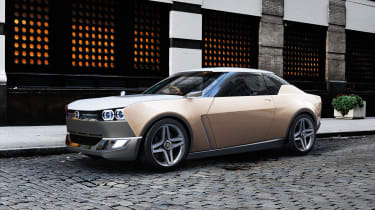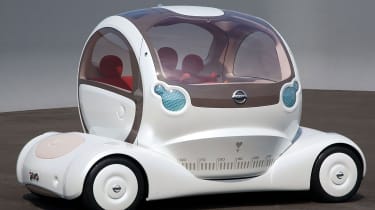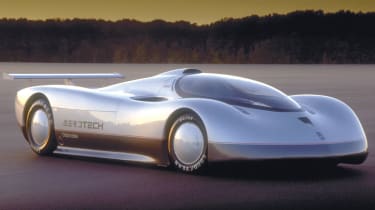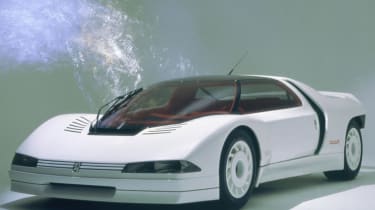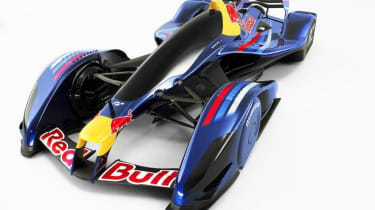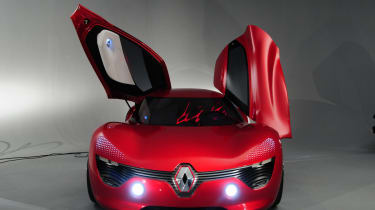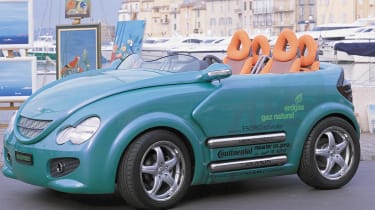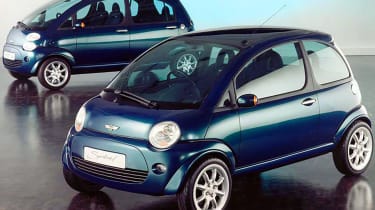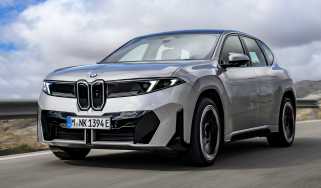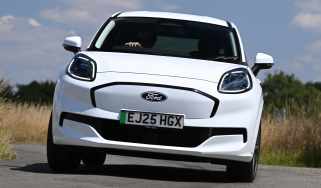Concept cars: the all-time greatest designs
Concept cars are what happens when the car industry lets its imagination run wild. We pick out the greatest ever concepts...
Nissan IDx (2013)
Nissan chose its home motor show to unleash the IDx concept on the world in 2013 and the world lapped it up. The Tokyo crowds were treated to not one by two IDx variants, the IDx Freeflow, a more subdued beige number, and the IDx Nismo resplendent in racing livery.
The cars are very much of the retro school of concept car design. Rather than vainly attempting to predict the automotive future, designer David Beasley cast his eye back to Nissan’s past and hit upon the Datsun 510. The IDx was essentially a modern reinterpretation of that car, a 3-box coupe aimed at a youthful audience, and after the show the clamour for Nissan to build a production version was intense.
It never did, but the retro concept car theme has gone from strength-to-strength since the IDx with the Honda Urban EV, Peugeot e-Legend and others following on where Nissan’s effort left off.
Nissan Pivo (2005)
We were first introduced to the compact, ultra-manoeuvrable Nissan Pivo electric city car back in 2005 and at first glance, one could have been forgiven for thinking it was just another “vision of future mobility” that would be forgotten by the next big motor show.
The Pivo, though, was a bit different. Designed purely for city driving, it featured four-wheel steering and great all-around visibility. On top of a battery-filled deck, the electric Pivo featured a unique 360-degree rotating cabin, eliminating the the need to reverse.
Interestingly, the car also featured a 3-seat layout with the driver sitting in the middle, one of the few design features it shared with a McLaren F1.
A couple of years later, a refreshed Pivo 2 was unveiled which was largely the same but could drive sideways crab-style.
The Pivo 3 came along in 2011 and reduced the turning circle to just four metres. Sadly, however, the third iteration of the mould-breaking EV did away with the car’s one unique feature, the rotating cabin. While more feasible for production, it lost the original car’s imagination, and thus was largely forgotten about by the next motor show.
Oldsmobile Aerotech (1987) f
In 1985, General Motors had just finished the development of its latest Oldsmobile “Quad-4” 2.3-litre four-cylinder petrol engine. It was innovative for its time, with an aluminium head, four valves per cylinder and dual overhead camshafts, producing 150bhp and 217Nm of torque.
The “Quad-4” engine outclassed its four-cylinder rivals from BMW and Mercedes, a fact which GM’s engineers were particularly proud of. So, to show the extent of their engine’s capabilities, the Aerotech project was devised and tasked with breaking some of the land-speed records of the period.
Like all good concepts, the project was carried out in secrecy, with the development for the tuned version of the Quad-4 engine being shrouded behind the standard engine’s use in the new Oldsmobile Cutlass and Pontiac Grand Am.
Two versions of the tuned Quad-4 engine were produced. The first was fitted with a single turbocharger, and produced around 800bhp. Not content with such conservative power figures, the engineers designed a second model in 1987, which featured a twin-turbo setup, producing upwards of 1000bhp.
The Aerotech’s chassis was borrowed from the series-winning 1985 March Engineering Indycar, while the body was built entirely from carbon-fibre, after being shaped in a wind-tunnel for maximum aerodynamic efficiency. In total, it weighed a meagre 726kg. Other innovative design features included an aerodynamically optimised underbody, consisting of a series of adjustable panels which could alter the amount of downforce the car generated.
As a result, the Aerotech was quick, even by today’s standards. It could achieve a top speed of 275mph, which is enough to outpace a Bugatti Chiron. In August 1987, it set a new speed record, averaging 267.39mph after two flying mile runs at the Ford Stockton test track.
Peugeot e-Legend (2018)
The e-Legend is a modern take on the classic Peugeot 504, and was unveiled at the 2018 Paris Motor Show. Interestingly, even though it was a concept, it was designed with “realistic,” showroom-friendly proportions, with properly-sized windows, no unrealistic overhangs and production-car-like 19-inch wheels.
Throughout, the e-Legend blends next-generation technology with 1960s materials. The 49-inch dash-width infotainment screen sits alongside retro wooden trim and velour upholstery. The wooden trim is projected on a pair of 29-inch screens that act as door cards, while a steering-wheel-mounted screen acts as the instrument binnacle.
The e-Legend is powered by a 100kWh battery pack, feeding an all-wheel-drive, all-electric drivetrain. Performance figures stand at 456bhp and 800Nm of torque; enough for a 0-62mph sprint of under four seconds and top speed of 137mph. Supposedly, it’ll cover 373 miles on a single charge under the new WLTP regulations, too.
Other innovative technological features include Peugeot’s latest autonomous driving capabilities. It’s available in two modes; a paired-back one displaying a minimal amount of information on the e-Legend’s infotainment system, and a busier mode which displays the full array of connectivity features. In both autonomous modes, the steering wheel folds away under the dash.
Peugeot Quasar (1984)
Peugeot has a proud history of supercar concepts, including spectacular efforts like the Oxia, 907 and Onyx, but the 1984 Peugeot Quasar stands out. Not only does it have the requisite concept car ground-hugging stance and scissor doors, it also forged a link between the gleaming motor show stands and the mud-soaked stages of Group B rallying.
The Peugeot took the heavily turbocharged 600bhp 4-cylinder engine from its legendary 205 T16 rally car and applied the Quasar’s sci-fi inspired bodywork and interior over the top. The all-wheel drive powertrain went on to prove its worth in spectacular style with the 205 T16 winning the World Rally Championship in 1985 and 1986.
Inside, the Quasar’s striking red leather and blue carpets were an acquired taste but it also featured a Clarion stereo and an early satellite navigation system that could send and receive teletext messages. Just in case the passenger got bored of reading the pacenotes.
Red Bull X2010 (2010)
Kazunori Yamauchi, the man behind the Gran Truismo video game series, posed an interesting question: "If you built the fastest racing car on land, one that throws aside all rules and regulations, what would that car look like, how would it perform, and how would it feel to drive?”. This was the answer from Red Bull Racing Engineering boss and F1 design legend Adrian Newey - the Red Bull X2010.
The car doesn’t exist outside of the Gran Truismo games and a motor show model but it has still found fame as a stunning indication of where F1 technology could go in the future. Aerodynamics are at its core with enclosed wheels and fan technology designed to suck the car to the road. A 1,479bhp engine provides the power with the aims of launching the 545kg machine to a 292mph top speed and pulling 6g in lateral forces.
Sebastian Vettel took the car on its first virtual test drive and is said to have lapped the Suzuka circuit over 20 seconds faster than modern Formula One cars could manage on the same simulator. Off the back of that, the Red Bull X2010 became so sought after in the Gran Turismo 5 game that fans were paying upwards of $250 to buy virtual versions of it on eBay.
Renault Dezir (2010)
Renault has developed a bit of a habit for creating bedroom poster concept cars and the Dezir, shown at the 2010 Paris Motor Show, certainly falls into that category. The Dezir concept was one of six concept cars designed by Renault to showcase the different stages of life that it customers might encounter but they also hinted at the future design language of the brand.
The Dezir was a fully functioning mid-engined electric sports car with the powertrain from the Fluence saloon and a tubular chassis from the Megane Trophy race-car. The styling is a blend of quirky French design, from the enormous Renault badges and grille stretching across the front, to the wave-like slats that adorn the tail. The asymmetrically hinged ‘butterfly’ doors are equally dramatic and complete the car’s outrageous yet functional look.
The Dezir never made it to production unfortunately, although you can clearly see elements of its design in current Renault models - particularly that full-width grille. Perhaps the biggest achievement that this car managed was that it put down the foundations for the return of the Alpine A110.
Renault Espace F1 (1995)
What do you get when you cross a typically French MPV with the engine of a Formula 1 car? The one-off, madcap Renault Espace F1.
Back in 1994, Renault was celebrating the 10th anniversary of the Espace MPV, a car so practical and versatile it went on to define the MPV sector for another two decades. Instead of having a simple birthday cake and some balloons, Renault decided to team up with its Formula 1 operation and insert one of its competition engines into the Espace.
The engine in question was a 3.5-litre V10 sourced from a 1993 Williams-Renault FW15C Formula 1 car but was tuned to give 820bhp instead of the regular 700bhp. Fitting such a large and powerful engine to the standard Espace meant some serious engineering changes, including putting the engine in the middle of the car and making the entire body out of carbon fibre (bar the hood, tailgate and roof panel which were carried over from the original Espace).
The resulting weight loss meant that the Espace F1 weighed only 1,300kg and was capable of 0-62 mph in just 2.8 seconds while hitting a top speed of 194 mph. Possibly the most impressive thing about this car was that it was still able to seat four people in four individual carbon-clad bucket seats with full harnesses. Whether you could find three passengers brave enough to climb in is another question but at least it proved that the Espace was still a practical MPV.
Rinspeed Presto (2002)
The people at Rinspeed have long been the kings of the bizarre concept car, and the Swiss firm arguably hit peak weirdness in 2002 with the Presto.
The tiny roadster had one hell of a party trick up its side-mounted silver rollers: an extending wheelbase. One push of a button stretches the Presto by 746mm - turning it from a two seat, three-metre long micro car into a four seater with more rear legroom than a typical family hatch.
The floorpan grew courtesy of a centrally-mounted electric motor and a pair of screw-and-nut gears. Despite the car looking like a 1950s bathtub with some Mercedes C-Class Sports Coupe lights attached, Rinspeed claimed that the Presto’s structural rigidity was strong enough to make it feel sturdy on the road.
Rinspeed’s madcap engineers didn’t stop with the design, either: they altered the Mercedes-sourced 1.7-litre engine so that it could run on a mix of diesel and natural gas. The cabin featured a Sony hi-fi - it even came with a few sets of wireless headphones so that you could still hear your tunes over the wind - and onlookers’ incredulous laughter.
Rover Mini Spiritual (1997)
Had Rover got its way back in the late nineties, you’d now be looking at the Mini for the 21st century. The Mini Spiritual concept aimed to succeed the original British motoring icon - not from a styling point of view, but by taking inspiration from its groundbreaking approach to the small car concept.
As a result, the Spiritual (and the larger Spiritual Too) promised exceptional packaging, thanks in no small part to its - at the time - revolutionary mid-engined layout and compact ‘Hydrogas’ suspension. The Spiritual was tiny at 3,000mm - the same length as the original Mini - yet inside it offered legroom to match a contemporary supermini. At 3,500mm, the Spiritual Too is 100mm shorter than a Volkswagen Up!, yet legroom matched that of the BMW 7 Series.
The mid-engined layout wasn’t just developed for practicality, but safety, too. The empty space up front allowed for a greater deformable volume in order to pass the more stringent crash tests that Rover predicted would become a factor in the 21st century automotive industry.
It all showed huge promise, but parent group BMW eventually preferred to succeed the Mini with a retro-styled premium product we have today. It would have been fascinating to see whether or not Rover’s interpretation would have achieved similar success.
Click the links below to jump to different sections of the list or click on to page 8 here...

